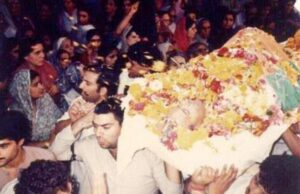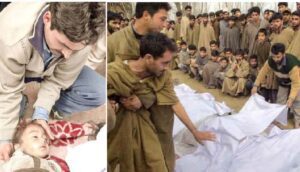Main Kashmir Pandit Hoon, Apne Hi Desh Mein Dandit Hoon (I am a Kashmiri Pandit, Tortured in My Own Country).
For over three decades, this has been my reality. The exodus, meant to be temporary, stole my home, my land, and my very identity. We, the Kashmiri Pandits, were driven from our ancestral lands by violence and terror.
Now, we huddle in cramped tenements, a constant reminder of what we’ve lost. Assurance of rehabilitation- a hollow Promise as the government throws us a pittance while offering others a full plate, as we are not a vote book for any government.
Lies from the media touting increased aid- a blatant and brazen lie.
The question burns: When will we return home? When will we be more than displaced ghosts in our land? The silence from those who promised a haven is deafening. This is the unending ordeal of the Kashmiri Pandits.

Here is the untold story of Kashmiri Pandits not told to you by the media.
The Unending Ordeal: The Kashmiri Pandit Exodus
Over three decades ago, a mass exodus of the minority Kashmiri Pandit community took place from the Kashmir Valley amidst rising terrorism and targeted killings by militants. What was hoped to be a temporary fleeing due to the volatile situation turned into a permanent displacement, uprooting an entire community from their ancestral homeland and way of life. The impact of this forced migration has been devastating, not just in terms of physical displacement but also in terms of the irretrievable loss of identity, culture, and a deep-rooted connection to the land that had defined the Pandit community for generations.
Life in Migrant Camps: A Struggle for Dignity
In the initial years following the exodus in the early 1990s, thousands of Kashmiri Pandit families were housed in makeshift migrant camps across Jammu, Delhi, and other cities. These camps, like Mishriwala, Purkhoo, Muthi, Jhiri, Nagrota, and Battal Ballian in Udhampur, were meant to be temporary shelters but became permanent residences for many. The living conditions in these camps were deplorable, with multiple generations forced to coexist in cramped quarters, often without separate cooking or bathing facilities.
Migrant Colonies Of Kashmiri Pandits: A Semblance of Permanence
In an attempt to provide a more permanent solution, the government developed colonies for Kashmiri Pandits like Jagti, Pampore, Mattan, and Vessu to house the displaced Pandits. However, these colonies failed to offer a dignified living environment, as the flats developed for Pandit migrants were plagued by infrastructural issues such as seeping roofs, damp walls, and ill-designed drainage systems.
Education and Healthcare: Neglected Priorities
The migrant camps and colonies have limited education facilities beyond primary schooling, trapping scores of Pandit children in a generational cycle of joblessness and economic despair. Healthcare services are restricted to periodic medical camps and under-equipped community centres within the colonies, forcing residents to throng overcrowded government hospitals in cities.
Loss of Land, Identity, and Unfulfilled Promises
Most tragically, the displaced Pandits have lost all connection to their generational properties, homes, agricultural lands, Festivals,and cultural moorings in Kashmir – an irreplaceable loss that has fragmented their community identity. The once-thriving Pandit neighbourhoods, temples, and cultural hubs in the Valley now stand deserted, a haunting reminder of the life they were forced to leave behind. Despite numerous promises of rehabilitation, the community’s sense of belonging and continuity has been shattered.

Socio-Economic Hardships and Stagnant Relief
The loss of livelihoods, properties, and agricultural lands in Kashmir dealt a severe blow to the economic stability of the displaced Pandit families. Many who had once lived affluent lives as successful businessmen, farmers, or professionals found themselves struggling to make ends meet in the migrant camps and colonies.
With limited employment opportunities, many were forced to take up low-paying private jobs or run small businesses from the camps to sustain their families. The government’s cash relief of Rs 13,000 (Maximum per family and Rs 3,250 for unmarried children – The relief amount is 3250, 6500 (Family of Two), 9750 (Family of 3), 13000 (A family of 4 and more), This the only monetary assistance for these migrants not having a government job– has remained stagnant since 2018, despite the rising cost of living and inflation. I want to reiterate here, that this relief is not applicable for a family, who had a government job.
Shockingly, this stagnation comes even as the government provided a 5kg ration guarantee to poor people across the rest of the country, highlighting the blatant disparity in treatment towards the Kashmiri Pandits and the rest of the population. I am not against Modi Ji’s guarantee to continue to offer a 5 Kg ration to the poor, but what about the guarantee of this government that guaranteed Kashmiri Pandits safe return and rehabilitation of Kashmiri Pandits in both the 2014 and 2019 manifestos, not sure what would be their manifesto in 2024 for Kashmiri Pandits. Is the relief amount sufficient enough for all those who have lost their homes, gardens, properties and sources of livelihood due to no fault of their own? The cost of essentials has more than doubled, but our pittance remains the same. Is this how the government expects us to survive after taking away everything we had?”
Amit Shah’s Lies in the Parliament
In a shocking display of misinformation, Union Home Minister Amit Shah made inaccurate statements about the number of Kashmiri Pandits receiving relief during a Parliament session. He falsely claimed that 44,000 families were receiving relief, while the reality was that only 22,000 families were beneficiaries.
Furthermore, Shah provided misleading information about the government providing a fixed amount of Rs 13,000 per month to each family when the actual relief amount varies depending on the number of family members and their circumstances as I mentioned above. Such blatant disregard for facts and figures related to the Pandit community’s plight has only deepened the sense of betrayal and distrust.
The BJP government’s actions towards the Kashmiri Pandits have been characterized by hollow assurances and blatant political exploitation. While claiming to provide 6,000 residential houses to employees through a program initiated by the previous Congress government, Amit Shah tried to portray it as a significant accomplishment of the BJP.
Propaganda and Media Lies
This was stated in the media “Delhi Lieutenant-Governor Vinai Kumar Saxena has approved a hike in the ad hoc monthly relief to Kashmiri migrant families from ₹10,000 to ₹27,000 per month, The L-G also allowed children of migrant families to make their cards and become eligible for the ad hoc monthly relief (AMR) as separate units.
However, this is Just a Propaganda and gimmick by the government using Media
The media report stating that the Delhi Lieutenant-Governor had approved an increase in the monthly relief amount for Kashmiri migrant families from ₹10,000 to ₹27,000 per month is a blatant lie, Far from the truth.
Instead, the change was related to the income criteria for eligibility to receive the relief. Previously, families with an income of up to ₹10,000 per month were eligible for the relief. The new announcement has raised this income threshold to ₹27,000 per month, meaning that families with a higher income level can now also qualify for the same relief amount.
Essentially, the relief amount itself, which was ₹13,000 per month for families in Delhi and Jammu, has not changed. The change is in the income eligibility criteria, which has been relaxed to include families with a higher income level.
While the move widens the pool of eligible families, it does not constitute an increase in the financial assistance itself, contrary to initial reports suggesting a hike in the monthly relief from ₹10,000 to ₹27,000.
Neglect of Kashmiri Pandits by the Judiciary
Adding to the community’s woes, even the country’s highest judicial institution, the Supreme Court of India, has neglected the plight of the Kashmiri Pandits. In a shocking display of apathy, the apex court dismissed a Public Interest Litigation (PIL) filed by a Pandit organization in 2017 “Roots in Kashmir” seeking an investigation into the killings of Kashmiri Pandits during the insurgency. The apex court dismissed a Public Interest Litigation (PIL citing 27 years citing that ” 27 years” had elapsed since the exodus.
The judiciary’s indifference has only deepened the sense of betrayal and alienation felt by the displaced Pandits, who have been denied justice and recognition at every turn.
The Million-Dollar Question: When Will Kashmiri Pandits Return Home?
As the Kashmiri Pandits continue to face the harsh realities of displacement, the million-dollar question remains unanswered: When will they be able to return to their homeland in Kashmir, the land they once called paradise on earth? Despite numerous promises and assurances from successive governments, the road to their rehabilitation and resettlement remains shrouded in uncertainty and riddled with obstacles.
The ongoing struggle of the Kashmiri Pandits is a stark reminder of the government’s failure to address one of the most pressing human rights issues in the nation’s recent history.
For more read following books




